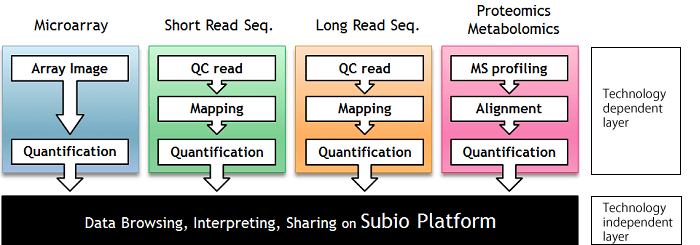Let's say. You are attending an RNA-Seq or microarray data analysis course. You will very likely start from collecting tools and data to set up the environment, and then handling the raw data files. Data processing, statistical analysis, and biological interpretation part will follow. Although the essential part is the last session, you will have already spent most of time and energy on the previous sections. You maybe will feel some satisfaction that you got much knowledge, but you realize you can't complete your task on your data files due to errors that didn’t occur during the training. What a waste of time, isn't it?
So, we recommend you think like the following.
The omics data analysis has two aspects of difficulties.
- The difficulty in interpreting data
- The difficulty in handling data and operating tools
The former is intrinsic and inevitable. The prequisite fact is that no one in the world can tell you how to extract the biological meaning from the data. So life science researchers should focus on challenging this kind of problems, not on any other.
On the other hand, the latter is avoidable if you feel it’s difficult for you because people who can use the tools are not who can extract the biological meaning. The intrinsic difficulty of bioinformatics is to understand the assumptions and limits of the algorithms to avoid misleading wrong conclusions from the analysis results. So, why won’t you give up learning operations, and alternatively focus on understanding the principles of algorithms?
By the way, here, I present a new aspect. Generally, the data analysis of raw data from a measurement system can be separated into the following two.
Here, I present a new aspect. Generally, the data analysis of raw data from a measurement system can be separated into two.
- The technology dependent layer
- The technology independent layer
Skills for the former are short-live because evolving technologies override continuously. Contrary, you can use the skills the latter for long as long as the observation target is the same. Consequently, learning priority should be on the latter.

Now we merge the conclusions above. You’ve already noticed that “difficulty in interpreting data in the biological context” largely overlaps learning skills for “the system independent layer,” haven’t you? If your capacity can’t cover the entire process, now you know what to prioritize in the learning.
We recommend you first learn operations of viewers of Subio Platform to understand the data, and correctly interpret it. We recommend not to try doing by yourself from the beginning, but use our Data Analysis Service to save your time and energy from spending on the not-so-important part.